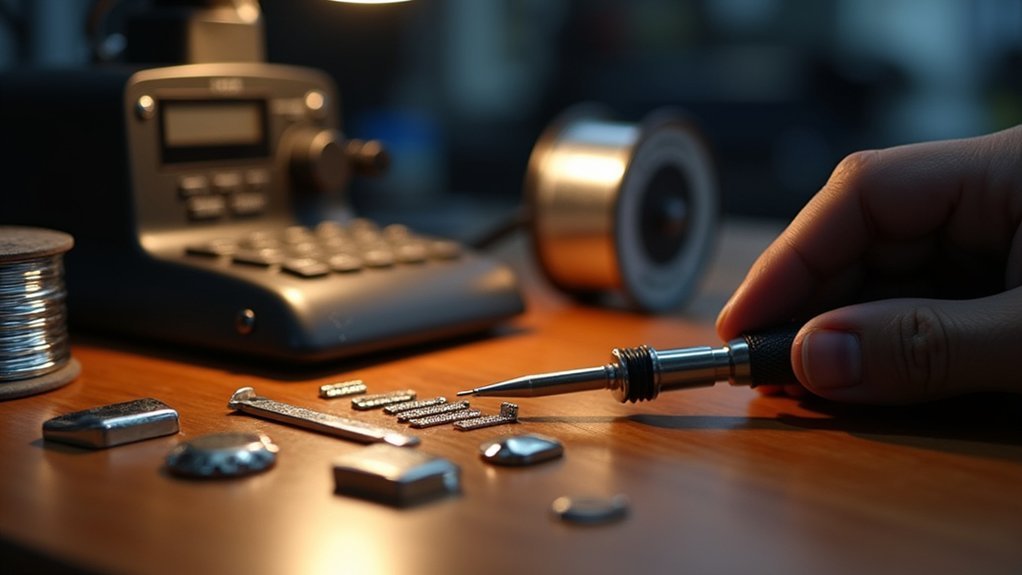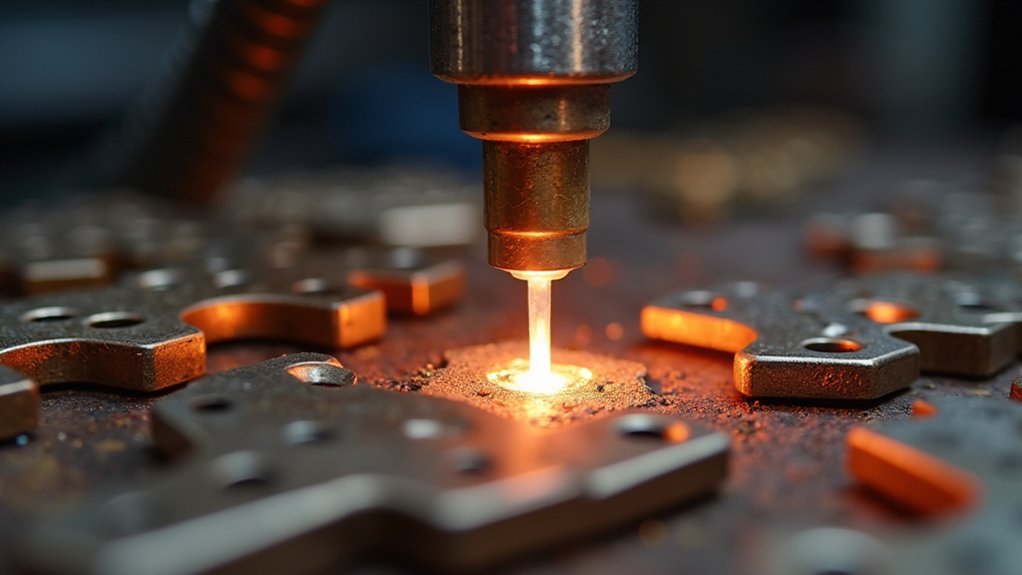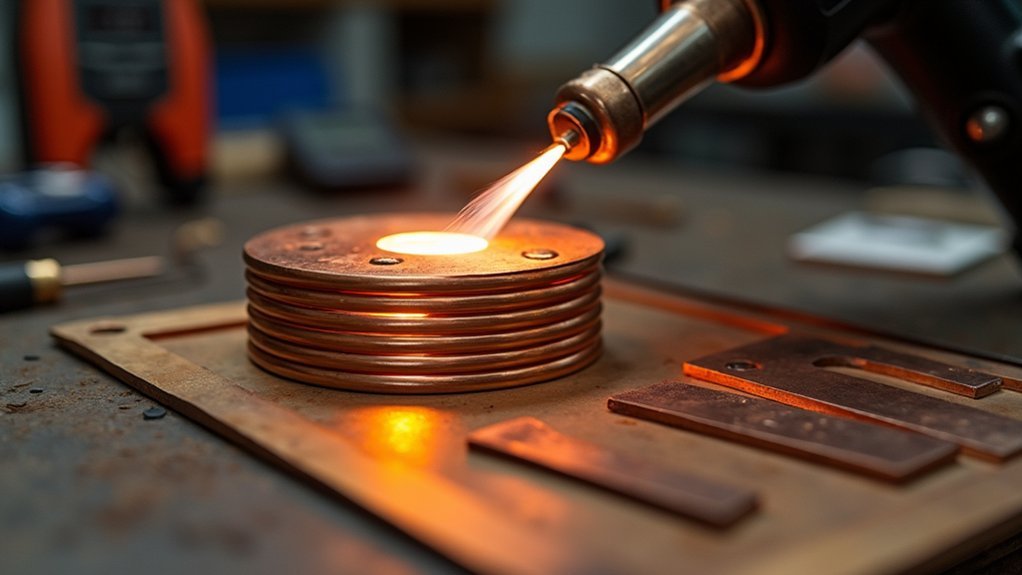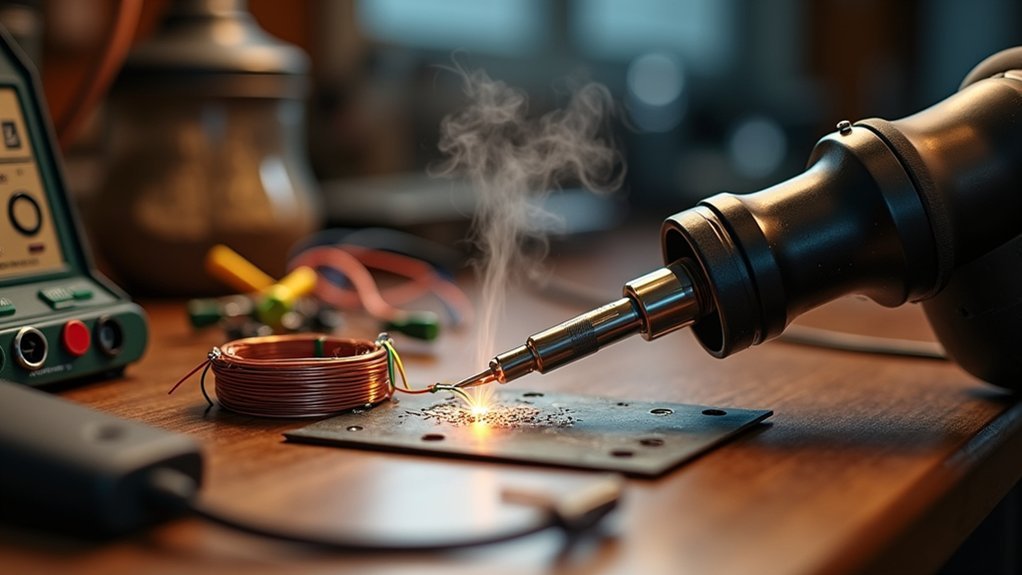You can master torch-free soldering with seven proven methods: soldering irons offering precise temperature control between 350°F-900°F, resistance soldering units generating direct electrical heat, hot air stations providing focused airflow up to 842°F, induction heating using electromagnetic fields for rapid results, electric heated platforms maintaining consistent temperatures, ultrasonic soldering employing high-frequency waves, and conductive adhesives containing metal particles for heat-free bonding. Each technique delivers superior precision while eliminating fire hazards and protecting sensitive components from thermal damage—discover which method suits your specific metalworking projects best.
Soldering Iron Techniques for Precision Metalwork

When you need precise control over heat application in metalwork, soldering irons offer an excellent torch-free alternative that’s particularly well-suited for delicate projects like jewelry making.
Operating between 350°F and 900°F, these tools let you target specific areas without affecting surrounding metal.
Choose a chisel or pointed tip for maximum precision. Always use flux to clean metal surfaces and help solder flow smoothly, creating stronger bonds.
Keep your iron’s tip clean with a wet sponge or brass cleaning pad to improve heat transfer and efficiency.
Apply solder directly to the heated metal rather than the iron tip to prevent oxidation and achieve cleaner joints.
Remember that proper ventilation is essential when working with solder and flux to protect your health.
Resistance Soldering Units for Controlled Heat Application
While soldering irons provide excellent precision for many metalworking tasks, resistance soldering units take controlled heat application to the next level by generating heat directly at the joint through electrical resistance.
You’ll find these units deliver better heat control through adjustable power settings, letting you fine-tune temperature based on your material’s thickness and type. Always wear safety glasses when operating these units, as sparks can occur during the heating process.
The variety of electrode tips makes joints easy to make across different metal types and applications.
You’ll appreciate the built-in timers that guarantee consistent heating cycles, improving your work’s repeatability. These units excel with delicate components since they minimize thermal distortion and prevent damage to surrounding areas.
Hot Air Stations for Localized Metal Joining

You’ll find hot air stations offer exceptional temperature control that lets you adjust heat precisely for different metals and component sensitivities.
The concentrated airflow delivers heat exactly where you need it, making these units perfect for detailed work on electronics and delicate jewelry pieces.
Without open flames, you’ll work more safely while achieving cleaner joints with minimal oxidation compared to traditional torch methods.
Temperature Control Advantages
Since hot air stations offer precise temperature adjustment between 100°C to 450°C (212°F to 842°F), you’ll gain exceptional control over your soldering process that torch-based methods simply can’t match.
You can fine-tune heat settings for different metals and soldering materials, preventing overheating that damages delicate components. This flexibility lets you work with various alloys while maintaining ideal temperatures throughout your project.
The gradual, uniform heat application protects sensitive parts from thermal shock, unlike torches that create sudden temperature spikes.
You’ll avoid the guesswork of flame-based heating, where hot metal temperatures fluctuate unpredictably. With digital displays showing exact temperatures, you can replicate successful soldering conditions consistently.
This precision eliminates wasted materials and reduces project failures, making your metalwork more reliable and professional.
Precision Heat Application
Hot air stations excel at directing concentrated heat streams to exact locations on your metalwork, giving you surgical precision that surpasses broad heating methods.
You’ll find the precision nozzles particularly valuable for focusing heat on small surfaces while protecting surrounding components from thermal damage. This targeted approach proves essential when working with delicate electronics or intricate metalwork where traditional torches would introduce excessive heat, potentially causing warping or melting.
The adjustable temperature settings, typically ranging from 100°C to 500°C, let you customize heat output for different metals and solder types.
You can work on complex assemblies without affecting nearby joints or components. Don’t forget to apply flux before heating – it’ll promote proper solder flow and adhesion, ensuring strong, reliable connections in your precision metalwork projects.
Safety Without Flames
When working with delicate metalwork or in confined spaces, hot air stations eliminate the fire hazards that come with traditional torch-based soldering methods.
You’ll operate at controlled temperatures between 180ºC and 400ºC, perfect for electronic components and thin metal parts. The heated airflow melts solder precisely without open flames, creating a safer workspace with reduced fire risks.
You can adjust the nozzles to direct heat exactly where needed, preventing damage to surrounding materials. This focused approach gives you better control over your soldering process while maintaining consistent results.
However, don’t skip proper ventilation—heated solder and materials still release fumes that require adequate airflow.
You’ll find hot air stations particularly valuable when working near flammable materials or in tight quarters where flame-based tools pose unnecessary risks.
Induction Heating Methods for Clean Solder Joints

You’ll find induction heating creates electromagnetic fields that generate heat directly within your metal pieces, eliminating the need for external flame sources.
Setting up requires specialized induction equipment that’s become increasingly affordable, though you’ll need to match your power requirements to your project size.
This method delivers exceptionally clean solder joints since it provides precise temperature control and reduces oxidation that typically occurs with torch-based techniques.
How Induction Heating Works
Although traditional torch-based soldering has dominated metalworking for decades, induction heating offers a revolutionary approach that generates heat directly within your metal workpiece through electromagnetic fields.
You’ll place your metal component inside an induction coil that creates a high-frequency alternating current. This current induces eddy currents within the metal itself, producing heat from the inside out.
You’ll achieve soldering temperatures within seconds, making this method perfect for high-volume production. The controlled heating process minimizes oxidation, resulting in cleaner solder joints with superior adhesion.
You’ll find this particularly valuable when working with small parts or delicate components, as the precise heat control reduces thermal damage to surrounding materials while maintaining efficiency.
Equipment and Setup Requirements
Since induction heating requires specialized equipment to generate the electromagnetic fields necessary for metalwork, you’ll need three core components: a power supply unit, an induction coil, and a suitable workpiece holder.
The power supply controls frequency output, which you’ll adjust based on your material and component size. Higher frequencies work best for smaller pieces, while lower frequencies suit larger metalwork.
Your coil design directly impacts heating efficiency, so choose one that matches your workpiece geometry. Position your metal carefully within the coil for ideal electromagnetic field exposure. Proper placement guarantees even heating and prevents hot spots that could compromise joint quality.
This setup delivers precise temperature control while keeping surrounding areas cool.
Joint Quality Benefits
When you use induction heating for soldering, you’ll achieve superior joint quality through precise temperature control that targets only the specific areas requiring heat. This localized heating minimizes oxidation and prevents overheating of surrounding materials, creating cleaner, stronger connections.
| Quality Factor | Traditional Torch | Induction Heating | Result |
|---|---|---|---|
| Oxidation Level | High | Minimal | Better metal contact |
| Heat Precision | Variable | Exact targeting | Cleaner joints |
| Contamination Risk | Present | Eliminated | Pure connections |
| Temperature Control | Manual estimation | Digital precision | Consistent quality |
You’ll notice faster processing times since induction heating reaches required temperatures quickly and efficiently. The flame-free environment protects sensitive components from unwanted heat effects while ensuring consistent results across multiple joints. This controlled approach delivers professional-grade metalwork quality every time.
Electric Heated Soldering Blocks and Platforms

While open flames pose risks in many workshops, electric heated soldering blocks and platforms offer a safer, more controlled alternative for metalwork projects.
You’ll benefit from consistent temperatures ranging from 300°F to 800°F, giving you precise heat control for ideal solder flow. Built-in thermostats maintain your desired temperature automatically, preventing overheating that could damage your work or materials.
Many models feature adjustable heating zones, letting you accommodate different metal types and sizes within a single session.
The insulating materials in quality units minimize heat loss, improving energy efficiency while keeping your workspace safer. By eliminating open flames entirely, you’ll considerably reduce fire hazards—making these platforms perfect for enclosed spaces and when working with sensitive materials that require careful temperature management.
Ultrasonic Soldering for Temperature-Sensitive Components
For applications requiring even greater temperature control, ultrasonic soldering harnesses high-frequency sound waves between 20 kHz and 70 kHz to create precise, localized heating at solder joints.
You’ll eliminate direct flame and excessive heat that could damage surrounding components, making this method ideal for temperature-sensitive work.
This technique minimizes thermal stress while achieving bond strengths comparable to traditional soldering. You can effectively join various materials, including metals and certain plastics, with exceptional precision.
You’ll need specialized equipment including a generator, transducer, and focused tool tip to direct ultrasonic energy.
This method excels in electronics, medical devices, and jewelry applications where heat sensitivity and precision are paramount for successful assembly.
Conductive Adhesives as Flame-Free Bonding Alternatives

Conductive adhesives step up as versatile alternatives that eliminate flame requirements while delivering reliable electrical connections between metal surfaces.
You’ll find these specially formulated solutions bond metals without heat, making them perfect for delicate applications where traditional soldering might damage sensitive components.
These adhesives contain metal particles like silver or copper, enhancing conductivity while creating strong electrical connections.
You can choose from various cure times—select fast-curing options for quick repairs or longer-setting formulas for extensive projects.
They’ll withstand humidity and temperature fluctuations, ensuring durability across different environments.
Most importantly, you’ll eliminate thermal stress and distortion risks that plague fragile materials during conventional soldering, making conductive adhesives your safest choice for temperature-sensitive metalwork applications.
Frequently Asked Questions
What Is the Best Gas for Silver Soldering?
You’ll get the best results using oxygen and propane for silver soldering. This combination creates a clean, hot flame that reaches proper temperatures without contaminating your silver with carbon deposits.
What Is the Best Gas for Soldering Jewelry?
You’ll find butane works best for most jewelry soldering since it produces clean flames perfect for delicate pieces. For platinum or larger items, you’ll want propane’s higher heat output instead.
Can You Solder With a Mini Torch?
You can absolutely solder with a mini torch. They’re perfect for jewelry work and small metalwork projects, reaching 2,500°F with butane or propane fuel for precise, controlled soldering applications.
What Are the Advantages of Torch Soldering?
You’ll get precise heat control and temperatures up to 6,000°F, letting you work quickly on delicate projects. You can use various solder types and fuel sources while flux prevents oxidation for stronger joints.
In Summary
You’ve now discovered seven effective alternatives to torch-based soldering that’ll give you precise control over your metalwork projects. Whether you’re working with delicate components or need clean, professional joints, these torch-free methods offer safer, more controlled heating options. Choose the technique that best matches your project requirements and workspace setup. With practice, you’ll find these methods often deliver superior results compared to traditional flame-based approaches.





Leave a Reply